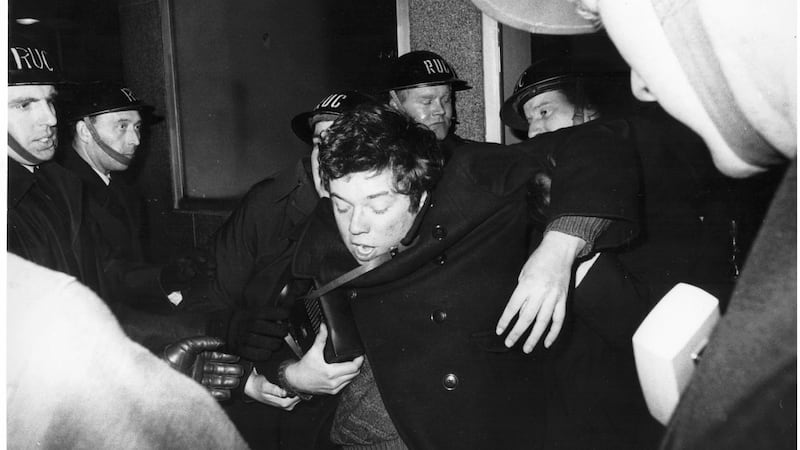It is the vivid faces that stand out most clearly in the photographs currently on display in the National Gallery of Photography in Dublin's Temple Bar. They form part of an exhibition curated by Seán O'Hagan, The Lost Moment – Civil Rights, Street Protest and Resistance in Northern Ireland, 1968-69, to mark the 50th anniversary of the events on which so much turned.
As Bernadette Devlin was to comment in the midst of it, "these people could never go back to the situation before". Part of the value of the exhibition is that it provides such a broad context and includes the stirrings and protests in Paris, Chicago, London and of course Prague, powerfully captured by photographer Josef Koudelka.
The vivid faces are not just those of the protesters, but also their oppressors, including Russian soldiers in Prague and older RUC men in Northern Ireland, well past their best baton-wielding days but still happy to try and smash open the head of an uppity Taig. There are also numerous children photographed, their visages a mixture of cheekiness, wonderment and fear.
Anger
Where were some of these adults and children returning to after their protests 50 years ago? Housing was central to the demands of the civil rights activists and generated much of the anger that is so palpable in the exhibition. I remember more than 20 years ago when I opened a book of Nell McCafferty's writings, The Best of Nell, published in 1984, being intrigued by the dedication at the beginning of the book: "To Bridget Bond, from Derry City, who started the fight for civil rights when it was neither fashionable nor popular."

My interest in Bond, not the household name in the Republic that some of the other civil rights leaders were, brought me to Derry to do research in the Derry City Council Archives where Bond’s collection of civil rights papers is held.
Two things are striking about this archive: the role of formidable women both in the Derry Housing Action Committee and the Derry Branch of the Northern Ireland Civil Rights Association (NICRA), and the sheer wretchedness of the housing situation for discriminated against Catholics.
Case notebooks
As secretary of the Derry NICRA, Bond kept detailed case notebooks about housing, and recorded such entries as “1967. One small room. One bed. One kitchen. One handicapped. Children always suffering from bad colds owing to dampness. Wife expecting fifth child and suffering with nerves and depression and husband afraid of something happening.” Another entry captured the inevitable fracturing of families: “15 in house. 6 years on list. Four children living with mother-in-law”, while another reads: “7 children. Eldest 5 years, youngest 5 weeks… twins, boy and girl 8 years and boy 12, sleeping with mother.”
The current exhibition argues that what it showcases is “the lost moment when the Troubles might have been averted”. The neatness of such a thesis has been challenged. Historian Simon Prince, who has written extensively about Northern Ireland in 1968, has long argued that its civil rights movement has been mythologised into an accepted version about wholly peaceful demonstrators being brutalised, but that “turning to the primary sources rather than trusting personal testimony reveals divided loyalties and different definitions of reform”.
‘Provocation worked’
What was happening in Selma and Paris taught activists in Northern Ireland “the same, simple, seminal lesson: provocation worked”. Prince is fond of quoting activist Eamonn McCann’s memoir: “Our conscious, if unspoken, strategy was to provoke the police into overreaction and thus spark off mass reaction against the authorities." This, suggests Prince, is at odds with the accepted narrative of the civil rights generation and it is incumbent on historians to “replace myth with something messier”.
Last week's runner-up in the presidential election, <a class="search" href='javascript:window.parent.actionEventData({$contentId:"7.1213540", $action:"view", $target:"work"})' polopoly:contentid="7.1213540" polopoly:searchtag="tag_person">Peter Casey</a>, has spoken about attending a civil rights march with his father in 1968
Reading Bridget Bond’s notebooks again and the scale of the misery and deliberate subjugation documented there, it is reasonable to conclude that provocation was justified. But Prince is correct that we need to be wary of uncluttered narratives and it is fair to point out that participants in historic events do not always make the most reliable historians of those events.
Some of Derry’s 68ers are still campaigning for social justice in their native hinterland, such as Devlin and McCann. Others in Derry at that time subsequently went off in completely different directions, geographically and ideologically.
Eight siblings
Last week's runner-up in the presidential election, Peter Casey, born to a Bogside family in 1957, has spoken about attending a civil rights march with his father in 1968.
Perhaps the 11-year-old Casey also had a vivid face, like those I looked at during the week. He has recounted his experience of living in a house with an outside toilet and eight siblings and his father’s membership of the Bogside Community Association. But whatever empathy was a part of his upbringing in relation to discrimination against those fighting hard for basic civil rights and equality seems to have been pulled up behind him like a ladder.













